|
|
|
Sort Order |
|
|
|
Items / Page
|
|
|
|
|
|
|
| Srl | Item |
| 1 |
ID:
103785


|
|
|
| 2 |
ID:
136210


|
|
|
|
|
| Summary/Abstract |
Biomass in the form of crop residues and firewood is a major energy source for rural households in China. A survey conducted in the provinces of Shanxi, Zhejiang, and Guizhou shows that 37 percent of rural households use bioenergy for heating and cooking and that bioenergy accounts for 18 percent of their total energy consumption. Most of the biomass used for energy is burned in traditional stoves, contributing to indoor air pollution in rural homes. Crop residues also are commonly burned in the fields, contributing to the high level of outdoor air pollution in China. Our econometric analysis of the key determinants of bioenergy use shows that bioenergy consumption falls modestly with income growth, increased time required for biomass collection, and less farmland. Hence, open burning of some biomass is an optimal choice and is likely to become more of a problem without policy intervention. These findings suggest that a more sustainable use of biomass requires policies that promote cleaner, more efficient bioenergy combustion technologies and increase the economic value of biomass such that local households can benefit from biomass collection.
|
|
|
|
|
|
|
|
|
|
|
|
|
|
|
|
| 3 |
ID:
103329


|
|
|
|
|
| Publication |
2011.
|
| Summary/Abstract |
The promotion and use of renewable energy sources are established priorities worldwide as a way to reduce emissions of Greenhouse Gases and promote energy security. Australia is committed to reach a target of 350 ML of biofuels per year by 2010, and incentives targeted to producers and consumers have been placed. These incentives include zero excise until 2011 for the ethanol produced in Australia and gradual increase of the taxation rates reaching the full excise of 0.125 AUD per litre by 2015. This paper analyses the viability of the second generation ethanol industry in the Green Triangle, one of the most promising Australian regions for biomass production, by comparing the energy adjusted pump prices of petrol and the produced ethanol under different taxation rates and forecasted oil prices. Major findings suggest that under the current conditions of zero fuel excise and oil prices around 80US$ per barrel ethanol production is viable using biomass with a plant gate cost of up to 74 AUD per ton. Moreover, the forecasted increase in oil prices have a higher impact on the price of petrol than the increased ethanol excise on the pump price of the biofuel. Thus, by 2016 feedstock with a plant gate cost of up to 190 AUD per ton might be used for ethanol production, representing a flow of 1.7 million tons of biomass per year potentially mitigating 1.2 million tons of CO2 by replacing fossil fuels with ethanol.
|
|
|
|
|
|
|
|
|
|
|
|
|
|
|
|
| 4 |
ID:
097430


|
|
|
|
|
| Publication |
2010.
|
| Summary/Abstract |
Biomasses created from natural resources such as firewood, charcoal and forest crops are still the main source of energy in many communities in the developing countries of the world. The absence of modern techniques, in terms of energy conversion and the lack of resource planning, places a great burden on the environment, not only in terms of deforestation but the polluting residual emissions created by the burning of such fuels. Even in some developed countries, it is possible to find rural areas that have no access to the conventional national electrical grid. The lack of this facility is detrimental to the social and economic development of any country or community. Renewable energy systems have been used in many cases to mitigate these problems. The present paper introduces the concept of an alternative Hybrid Power System configuration that combines photovoltaic modules and digesters fuelled by goat manure as the basis for rural sustainable development. Attention is drawn to the Northeast Region of Brazil, one of the largest semi-arid regions in a single country. The regional conditions of Northeast of Brazil are not unique, suggesting that other countries of a similar nature would benefit from the same energy system.
|
|
|
|
|
|
|
|
|
|
|
|
|
|
|
|
| 5 |
ID:
103370
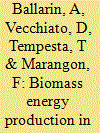

|
|
|
|
|
| Publication |
2011.
|
| Summary/Abstract |
Energy production from biomasses can be an important resource that, when combined with other green energies such as wind power and solar plants, can contribute to reduce dependency on fossil fuels. The aim of this study is to assess how agriculture could contribute to the production of bio-energy. A multi-period Weighted Goal Programming model (MpWGP) has been applied to identify the optimal land use combinations that simultaneously maximise farmers' income and biomass energy production under three concurrent constraints: water, labour and soil availability. Alternative scenarios are considered that take into account the effect of climate change and social change. The MpWGP model was tested with data from the Rovigo county area (Italy) over a 15-year time period.
Our findings show that trade-off exists between the two optimisation targets considered. Although the optimisation of the first target requires traditional agricultural crops, which are characterised by high revenue and a low production of biomass energy, the latter would be achievable with intensive wood production, namely, high-energy production and low income. Our results also show the importance of the constraints imposed, particularly water availability; water scarcity has an overall negative effect and specifically affects the level of energy production.
|
|
|
|
|
|
|
|
|
|
|
|
|
|
|
|
| 6 |
ID:
166706
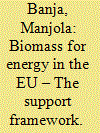

|
|
|
|
|
| Summary/Abstract |
This paper aims to produce a quantitative approach on the overall measures and on public support framework for biomass for energy, based on the EU countries reports under RED and existing literature. The way in which the support for biomass is implemented in the EU energy sector is not similar across EU countries. Feed-in tariffs and feed-in-premiums are still the dominant support schemes for the deployment of bioelectricity, whereas subsidies remain the main support for bioheat. Furthermore, a vast number of EU countries apply mandatory blending quotas for biofuels for transport. The paper shows that biomass for energy has a key role within the EU policy support for RES, in which targets are the main drivers, together with overarching biomass guidelines to anticipate any environmental constraints. Stable support showed the highest effectiveness in the past and remains the key factor for biomass deployment beyond 2020. The renewed targets need to be accompanied by long-term support measures and a commonly shared policy vision. A further harmonization of public bioenergy support towards a single EU cleaner energy market is recommended. This implies four policy actions for all EU countries: in-depth efficiency review, integration with RED-2, compatible sustainability guidelines and local impact assessments.
|
|
|
|
|
|
|
|
|
|
|
|
|
|
|
|
| 7 |
ID:
092849


|
|
|
|
|
| Publication |
2009.
|
| Summary/Abstract |
With biomass staying high in the EU political agenda and most of the recent documents acknowledging that it has the potential to make a very significant contribution to reaching the 20% target, the issue of supply in terms of feedstock types, availability constraints and costs in different Member States is set to determine the future technology uptake and market deployment prospects.
This paper is based on one of the initial studies, 'Bioenergy's role in the EU market. A view of developments until 2020', and presents a structured review for EU biomass resources, aiming to map technical potentials and provide detailed information on availability, costs and future trends for biomass potentials of different residual feedsctocks in EU27.
|
|
|
|
|
|
|
|
|
|
|
|
|
|
|
|
| 8 |
ID:
166521
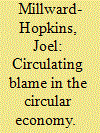

|
|
|
|
|
| Summary/Abstract |
The transition from coal-based electricity to ‘carbon neutral’ biofuels derived from forests has catalysed a debate largely centred upon whether woody-biofuels drive deforestation. Consequently, a crucial point is often missed. Most wood pellets used in electricity production are derived from waste-wood; a practice considered acceptable by many otherwise strongly opposed to the industry. We highlight that, precisely because waste-wood is a ‘waste’, its carbon-neutral credentials should be questioned. We then examine a parallel development occurring within the same industrial system; the recovery of electricity producers’ combustion-ash residues for concrete production. Contrasting how accounting practices allocate upstream carbon to these ‘wastes’ in the cases of wood pellets and coal-ash reveals how decisions are shaped by industry imperatives, rather than established lifecycle techniques. If the politics of emissions allocation continue to evolve in this way, it may become increasingly difficult to distinguish where progress towards a low-carbon, environmentally sustainable and circular economy is real, from where it is an artefact of biased and inconsistent accounting practices.
|
|
|
|
|
|
|
|
|
|
|
|
|
|
|
|
| 9 |
ID:
124333
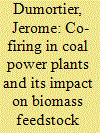

|
|
|
|
|
| Summary/Abstract |
Several states have a renewable portfolio standard (RPS) and allow for biomass co-firing to meet the RPS requirements. In addition, a federal renewable fuel standard (RFS) mandates an increase in cellulosic ethanol production over the next decade. This paper quantifies the effects on local biomass supply and demand of different co-firing policies imposed on 398 existing coal-fired power plants. Our model indicates which counties are most likely to be able to sustain cellulosic ethanol plants in addition to co-firing electric utilities. The simulation incorporates the county-level biomass market of corn stover, wheat straw, switchgrass, and forest residues as well as endogenous crop prices. Our scenarios indicate that there is sufficient feedstock availability in Southern Minnesota, Iowa, and Central Illinois. Significant supply shortages are observed in Eastern Ohio, Western Pennsylvania, and the tri-state area of Illinois, Indiana, and Kentucky which are characterized by a high density of coal-fired power plants with high energy output.
|
|
|
|
|
|
|
|
|
|
|
|
|
|
|
|
| 10 |
ID:
166348


|
|
|
|
|
| Summary/Abstract |
Biomass utilization is a strategy to decrease greenhouse gas (GHG) emissions in the European Union (EU) but bioenergy in the United States (US) is currently limited. As a result, biomass is increasingly exported from the US to the EU, but changes to the policy landscape are poised to alter this. This study utilizes Life Cycle Assessment (LCA) to assess impacts of biomass transportation on bioenergy life cycle GHG emissions. Transportation modes considered include truck, train and sea freight and each are assessed at realistic distances expected in bioenergy supply chains. Emissions for biomass firing alone and co-firing with coal using wood chips and pellets are compared to a baseline coal-fired power plant. Results include life cycle emissions for each case, and sensitivity analysis is presented for variation in power plant efficiency and biomass heating value. A generalized model for estimation of bioenergy emissions is presented. In nearly all cases, biomass utilization for electricity production produces lower life cycle GHG emissions compared to the coal baseline, with emission reductions as high as 76%. Utilization in the US and EU have similar overall emissions at long US distances. Policy implications are discussed in the context of current US and EU policies.
|
|
|
|
|
|
|
|
|
|
|
|
|
|
|
|
| 11 |
ID:
050514
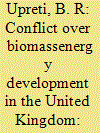

|
|
|
|
|
| Publication |
March 2004.
|
| Summary/Abstract |
The aim of this paper is to examine the causes of conflict over biomass energy development in the United Kingdom. This paper discusses social dimensions of development of biomass power plants. Based on the four case studies from England and Wales this paper examines impacts of public oppositions on planning permission. This paper revels that public opposition is one of the major obstacles to promote biomass energy. Though local communities value environmental benefits of biomass energy, they concern more on the immediate negative local effects of power plants to their areas. Main sources of public conflict over biomass energy development were related to location of the plant, perceived risks, and negative effects to ecology and landscape compared to few economic benefits to local people. Other factors contributing to the conflict were feeling of injustice, weak public relation strategy of the developers and low level of awareness. The paper concludes that biomass energy can be promoted only if all actors: the central government, developers, local councils, environmental concern groups and local communities make collective efforts. Such collaborative efforts need drastic shift in the current approach of biomass energy development.
|
|
|
|
|
|
|
|
|
|
|
|
|
|
|
|
| 12 |
ID:
127515
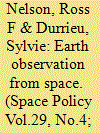

|
|
|
|
|
| Publication |
2013.
|
| Summary/Abstract |
Remote sensing scientists work under assumptions that should not be taken for granted and should, therefore, be challenged. These assumptions include the following:
1. Space, especially Low Earth Orbit (LEO), will always be available to governmental and commercial space entities that launch Earth remote sensing missions.
2. Space launches are benign with respect to environmental impacts.
3. Minimization of Type 1 error, which provides increased confidence in the experimental outcome, is the best way to assess the significance of environmental change.
4. Large-area remote sensing investigations, i.e. national, continental, global studies, are best done from space.
5. National space missions should trump international, cooperative space missions to ensure national control and distribution of the data products.
At best, all of these points are arguable, and in some cases, they're wrong. Development of observational space systems that are compatible with sustainability principles should be a primary concern when Earth remote sensing space systems are envisioned, designed, and launched. The discussion is based on the hypothesis that reducing the environmental impacts of the data acquisition step, which is at the very beginning of the information stream leading to decision and action, will enhance coherence in the information stream and strengthen the capacity of measurement processes to meet their stated functional goal, i.e. sustainable management of Earth resources. We suggest that unconventional points of view should be adopted and when appropriate, remedial measures considered that could help to reduce the environmental footprint of space remote sensing and of Earth observation and monitoring systems in general. This article discusses these five assumptions in the context of sustainable management of Earth's resources. Taking each assumption in turn, we find the following:
(1) Space debris may limit access to Low Earth Orbit over the next decades.
(2) Relatively speaking, given that they're rare event, space launches may be benign, but study is merited on upper stratospheric and exospheric layers given the chemical activity associated with rocket combustion by-products.
(3) Minimization of Type II error should be considered in situations where minimization of Type I error greatly hampers or precludes our ability to correct the environmental condition being studied.
(4) In certain situations, airborne collects may be less expensive and more environmentally benign, and comparative studies should be done to determine which path is wisest.
(5) International cooperation and data sharing will reduce instrument and launch costs and mission redundancy. Given fiscal concerns of most of the major space agencies - e.g. NASA, ESA, CNES - it seems prudent to combine resources.
|
|
|
|
|
|
|
|
|
|
|
|
|
|
|
|
| 13 |
ID:
093532


|
|
|
|
|
| Publication |
2010.
|
| Summary/Abstract |
In several policy documents bioenergy is recognized as an important renewable energy source in Italy. The increase in energy prices represents an opportunity for lignocellulosic energy crops such as acacia and poplar.
However, for Short Rotation Coppice (SRC) and Short Rotation Forestry (SRF) to be adopted by farmers, these crops must be perceived to be at least as profitable as crops that normally compete with these plantations for land use.
The purpose of this paper is to evaluate the economic feasibility of acacia (Robinia pseudoacacia) as an energy crop in a low input production regime in Italy and, in particular, to consider its competitiveness with wheat. Our results show that neither SRC and SRF techniques using assumed production costs (€3820 and €5285 ha-1 yr-1) nor biomass productions are able to obtain a positive profit (-€184 and -€172 ha-1 yr-1) that can convince farmers to invest in biomass plantations on their land. The results demonstrate that wheat is a more economically secure option than SRC or SRF.
The viability of local biomass production in Italy and Southern Europe depends on the active support of the governments; without them, biomass is not economically competitive for the farmers when compared to crops such as wheat.
|
|
|
|
|
|
|
|
|
|
|
|
|
|
|
|
| 14 |
ID:
127203


|
|
|
|
|
| Publication |
2014.
|
| Summary/Abstract |
The increases in a country's energy capacity are related to its gross domestic product (GDP). In Brazil, increases in income and the consumption of goods and services have led to an increase in the generation of solid waste (SW), which is sent to landfills as a method of treatment and final disposal. The purpose of this study was to facilitate an increase in energy generation from renewable resources, specifically from landfills via thermal biogas plants, and the research was divided into two phases. The first phase involved the assessment of the potential population size contributing to the landfill, which could result in the installation of a financially viable enterprise to generate electricity in Brazil. Next, an estimate of the costs associated with the generation and collection of solid waste in Brazil was predicted by GDP prognoses, the latter being in accordance with the National Energy Balance (Balanço Energético Nacional - BEN) plan created by the Mines and Energy Ministry of Brazil (Ministério de Minas e Energia do Brasil - MME). The net present value (NPV) and internal rate of return (IRR) of each enterprise scenario was used in the first stage to assess the plan's financial viability. In the second stage, estimation curves such as logistics, decreasing rate of growth, and logarithmic curves were used to establish relationships between the generation scenarios and the projected collection of SW and projected GDP. Thus, a range of possible landfill biogas/methane generation values and installed energy capacities were created, considering the extreme maximum and minimum values. These values were related to the energy sources from residual fuels reported by BEN. The results demonstrated that such values still represented a small percentage (0.00020% in 2010 and 0.44496-0.81042% in 2030) of the projected energy generation from residual fuels. Thus, an urgent need was identified to formulate policies that would encourage landfills as a source of renewable energy, broadening the number of financially viable initiatives for energy generation from landfill biogas for populations of fewer than 200,000 inhabitants.
|
|
|
|
|
|
|
|
|
|
|
|
|
|
|
|
| 15 |
ID:
092758


|
|
|
|
|
| Publication |
2009.
|
| Summary/Abstract |
This study proposes a game-theoretic approach to model and analyze the process of utilizing biomass for power generation considering three players: distributor, facility developer, and participating farmer. We characterize the Nash equilibrium of the sequential game and discuss its features. A special attention is devoted to the analysis of the impact of incentives and initial target on the equilibrium, in which the biomass is part of electricity production.
|
|
|
|
|
|
|
|
|
|
|
|
|
|
|
|
| 16 |
ID:
128380
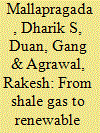

|
|
|
|
|
| Publication |
2014.
|
| Summary/Abstract |
We present an energy roadmap for the US light duty vehicle (LDV) sector that efficiently utilizes natural gas (NG) and transitions to renewable energy and carbon sources as they become economical. We use well-to-wheels (WTW) efficiency to compare alternative NG transportation pathways. If internal combustion engine vehicles (ICEVs) remain prevalent, then compressed natural gas (CNG) is the favored fuel. Among electric powertrains, centralized electricity generation with battery electric vehicle (BEV) is more efficient than on-board generation with fuel-cell vehicles (FCV). Plug-in hybrid electric vehicles (PHEVs) balance driving range against WTW efficiency, and provide flexibility in sourcing electricity from different energy sources. Despite these efficient WTW pathways, supplying NG for the LDV sector is estimated to decrease the lifetime of current US NG reserves to about 60 years. Beyond this period, compressed methane derived from biomass can replace CNG, and utilize the would-be developed CNG infrastructure. The LDV biomass requirement depends on the biomass to methane carbon conversion and battery storage capacity of CNG PHEVs. Converting biomass to methane using solar heat/H2 leads to ~65% lower LDV biomass requirement compared to standalone processes recovering ~30% biomass carbon as methane. The resulting biomass amounts compare favorably with future US biomass supply projections.
|
|
|
|
|
|
|
|
|
|
|
|
|
|
|
|
| 17 |
ID:
094837
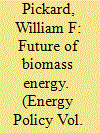

|
|
|
|
|
| Publication |
2010.
|
| Summary/Abstract |
It is argued: (i) that the harvesting of terrestrial solar radiation to perform useful work is at least an order of magnitude more efficient when carried out by solar-thermal or solar-photovoltaic processes than when carried out by way of biomass conversion and (ii) that, therefore, biomass energy is unlikely to compete successfully with inanimately harvested solar energy-except of course in restricted niche applications.
|
|
|
|
|
|
|
|
|
|
|
|
|
|
|
|
| 18 |
ID:
177422
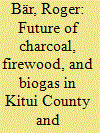

|
|
|
|
|
| Summary/Abstract |
Most households in sub-Saharan Africa rely on wood-based cooking fuels and their number is expected to rise. Despite this, national and subnational energy policies often neglect biomass cooking fuels. A Formative Scenario Analysis process is applied to show how the cooking fuel sector in Kilimanjaro Region (Tanzania) and Kitui County (Kenya) might evolve by 2030. In order to provide relevant knowledge for potential energy policies, this paper aims to identify the main drivers impacting the cooking fuel sector, and to assess and explore current and future demand and supply potential of biomass cooking fuels.
|
|
|
|
|
|
|
|
|
|
|
|
|
|
|
|
| 19 |
ID:
111385


|
|
|
|
|
| Publication |
2012.
|
| Summary/Abstract |
This paper presents a choice experiment analyzing the consumers' preferences towards a policy for replacing conventional electricity with electricity generated from forest biomass. The results show that consumers specially prefer the effects related to the lower risk of forest fires and to the decrease in pressure on non-renewable resources. The article also presents a methodological test in relation to the payment timeframe and its effect on marginal willingness to pay and consistency of responses using choice experiments. The most frequent and realistic payments are associated with lower presence of inconsistent responses. Finally, we cannot reject the null hypothesis of no effects of payment timeframe on marginal willingness to pay.
|
|
|
|
|
|
|
|
|
|
|
|
|
|
|
|
| 20 |
ID:
111347
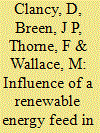

|
|
|
|
|
| Publication |
2012.
|
| Summary/Abstract |
A target of 30 per cent substitution of biomass for peat in the three peat fired power stations from 2015 has been set by the Irish Government. However, a knowledge gap exists on the extent to which Irish farmers would actually choose to grow these crops. An extension of the Renewable Energy Feed in Tariff (REFIT) scheme to include the co-firing of biomass with peat in electricity generation would enable the power stations to enter into Power Purchase Agreements (PPAs). These offer a fixed price to farmers for biomass feedstock. The decision to adopt biomass is represented as a constrained problem under certainty with the objective of profit maximisation. The results showed that the price offered under a PPA has a large effect on the economic returns from biomass crops. The price that the power stations previously estimated they would be able to pay, at €46 and €48 per tonne for willow and miscanthus, respectively, was used as a starting point. At this price the number of farmers who would choose to adopt biomass production is insufficient to achieve the national co-firing target. The target could be achieved at €70 and €65 per tonne for willow and miscanthus, respectively.
|
|
|
|
|
|
|
|
|
|
|
|
|
|
|
|
|
|
|
|
|